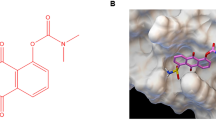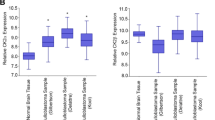Abstract
Medulloblastoma (MB) is the most common malignancy in children arising in the brain. Morbidities associated with intensive therapy are serious concerns in treating MB. Our aim was to identify novel targets and agents with less toxicity for treating MB. Specificity protein 1 (Sp1) transcription factor regulates several genes involved in cell proliferation and cell survival including survivin, an inhibitor of apoptosis protein. We previously showed that tolfenamic acid (TA), a nonsteroidal anti-inflammatory drug, inhibits neuroblastoma cell growth by targeting Sp1. We investigated the anticancer activity of TA using human MB cell lines and a mouse xenograft model. DAOY and D283 cells were treated with vehicle (dimethyl sulfoxide) or TA (5–50 μg/ml), and cell viability was measured at 1–3 days posttreatment. TA inhibited MB cell growth in a time- and dose-dependent manner. MB cells were treated with vehicle or TA (10 μg/ml), and the effect on cell apoptosis was measured. Apoptosis was analyzed by flow cytometry (annexin V staining), and caspase 3/7 activity was determined using Caspase-Glo kit. The expression of Sp1, cleaved poly(ADP-ribose) polymerase (c-PARP), and survivin was determined by Western blot analysis. TA inhibited the expression of Sp1 and survivin and upregulated c-PARP. Athymic nude mice were subcutaneously injected with D283 cells and treated with TA (50 mg/kg, three times per week) for 4 weeks. TA caused a decrease of ~40 % in tumor weight and volume. The tumor growth inhibition was accompanied by a decrease in Sp1 and survivin expression in tumor tissue. These preclinical data demonstrate that TA acts as an anticancer agent in MB potentially targeting Sp1 and survivin.





Similar content being viewed by others
References
Koto KS, Lescault P, Brard L, Kim K, Singh RK, Bond J, et al. Saulnier Sholler GL: Antitumor activity of nifurtimox is enhanced with tetrathiomolybdate in medulloblastoma. Int J Oncol. 2011;38:1329–41.
Jemal A, Bray F, Center MM, Ferlay J, Ward E, Forman D. Global cancer statistics. CA Cancer J Clin. 2011;61(2):69–90.
Taylor RE, Bailey CC, Robinson K, Weston CL, Ellison D, Ironside J, et al. Results of a randomized study of preradiation chemotherapy versus radiotherapy alone for nonmetastatic medulloblastoma: the International Society of Paediatric Oncology/United Kingdom Children’s Cancer Study Group PNET-3 study. J Clinical Oncol Off J Am Soc Clin Oncol. 2003;21:1581–91.
de Bont JM, Packer RJ, Michiels EM, den Boer ML, Pieters R. Biological background of pediatric medulloblastoma and ependymoma: a review from a translational research perspective. Neuro-Oncology. 2008;10:1040–60.
Ris MD, Packer R, Goldwein J, Jones-Wallace D, Boyett JM. Intellectual outcome after reduced-dose radiation therapy plus adjuvant chemotherapy for medulloblastoma: a Children’s Cancer Group study. J Clinical Oncol Off J Am Soc Clin Oncol. 2001;19:3470–6.
Kotipatruni RR, Nalla AK, Asuthkar S, Gondi CS, Dinh DH, Rao JS. Apoptosis induced by knockdown of uPAR and MMP-9 is mediated by inactivation of EGFR/STAT3 signaling in medulloblastoma. PLoS One. 2012;7:e44798.
Ball S, Li C, Li PK, Lin J. The small molecule, LLL12, inhibits STAT3 phosphorylation and induces apoptosis in medulloblastoma and glioblastoma cells. PLoS One. 2011;6:e18820.
Yang F, Jove V, Xin H, Hedvat M, Van Meter TE, Yu H. Sunitinib induces apoptosis and growth arrest of medulloblastoma tumor cells by inhibiting STAT3 and AKT signaling pathways. Mol Can Res: MCR. 2010;8:35–45.
Yu LJ, Wu ML, Li H, Chen XY, Wang Q, Sun Y, et al. Inhibition of STAT3 expression and signaling in resveratrol-differentiated medulloblastoma cells. Neoplasia. 2008;10:736–44.
Kadonaga JT, Carner KR, Masiarz FR, Tjian R. Isolation of cDNA encoding transcription factor Sp1 and functional analysis of the DNA binding domain. Cell. 1987;51:1079–90.
Kadonaga JT, Courey AJ, Ladika J, Tjian R. Distinct regions of Sp1 modulate DNA binding and transcriptional activation. Science. 1988;242:1566–70.
Abdelrahim M, Baker CH, Abbruzzese JL, Safe S. Tolfenamic acid and pancreatic cancer growth, angiogenesis, and sp protein degradation. J Natl Cancer Inst. 2006;98:855–68.
Basha R, Baker CH, Sankpal UT, Ahmad S, Safe S, Abbruzzese JL, et al. Therapeutic applications of NSAIDs in cancer: special emphasis on tolfenamic acid. Front Biosci (Schol Ed). 2011;3:797–805.
Chang WC, Chen BK. Transcription factor sp1 functions as an anchor protein in gene transcription of human 12(S)-lipoxygenase. Biochem Biophys Res Commun. 2005;338:117–21.
Lu S, Archer MC. Sp1 coordinately regulates de novo lipogenesis and proliferation in cancer cells. Int J Cancer. 2009;126(2):416–25.
Adida C, Berrebi D, Peuchmaur M, Reyes-Mugica M, Altieri DC. Anti-apoptosis gene, survivin, and prognosis of neuroblastoma. Lancet. 1998;351:882–3.
Islam A, Kageyama H, Takada N, Kawamoto T, Takayasu H, Isogai E, et al. High expression of survivin, mapped to 17q25, is significantly associated with poor prognostic factors and promotes cell survival in human neuroblastoma. Oncogene. 2000;19:617–23.
Obexer P, Hagenbuchner J, Unterkircher T, Sachsenmaier N, Seifarth C, Bock G, et al. Repression of BIRC5/survivin by FOXO3/FKHRL1 sensitizes human neuroblastoma cells to DNA damage-induced apoptosis. Mol Biol Cell. 2009;20:2041–8.
Abdel-Aziz A, Mohamed MA, Akl FM, Taha AN. Survivin expression in medulloblastoma: a possible marker for survival. POR: Pathology oncology research; 2012. doi:10.1007/s12253-012-9594-9.
Pizem J, Cort A, Zadravec-Zaletel L, Popovic M. Survivin is a negative prognostic marker in medulloblastoma. Neuropathol Appl Neurobiol. 2005;31:422–8.
Gately S, Li WW. Multiple roles of cox-2 in tumor angiogenesis: a target for antiangiogenic therapy. Semin Oncol. 2004;31:2–11.
Jacoby RF, Seibert K, Cole CE, Kelloff G, Lubet RA. The cyclooxygenase-2 inhibitor celecoxib is a potent preventive and therapeutic agent in the min mouse model of adenomatous polyposis. Cancer Res. 2000;60:5040–4.
Tarnawski AS, Jones MK. Inhibition of angiogenesis by NSAIDs: molecular mechanisms and clinical implications. J Mol Med. 2003;81:627–36.
Baryawno N, Sveinbjornsson B, Eksborg S, Orrego A, Segerstrom L, Oqvist CO, et al. Tumor-growth-promoting cyclooxygenase-2 prostaglandin E2 pathway provides medulloblastoma therapeutic targets. Neuro Oncol. 2008;10:661–74.
King Jr JG, Khalili K. Inhibition of human brain tumor cell growth by the anti-inflammatory drug, flurbiprofen. Oncogene. 2001;20:6864–70.
Basha R, Ingersoll SB, Sankpal UT, Ahmad S, Baker CH, Edwards JR, et al. Tolfenamic acid inhibits ovarian cancer cell growth and decreases the expression of c-met and survivin through suppressing specificity protein transcription factors. Gynecol Oncol. 2011;122:163–70.
Colon J, Basha MR, Madero-Visbal R, Konduri S, Baker CH, Herrera LJ, et al. Tolfenamic acid decreases c-Met expression through Sp proteins degradation and inhibits lung cancer cells growth and tumor formation in orthotopic mice. Invest New Drugs. 2011;29:41–51.
Jia Z, Gao Y, Wang L, Li Q, Zhang J, Le X, et al. Combined treatment of pancreatic cancer with mithramycin A and tolfenamic acid promotes Sp1 degradation and synergistic antitumor activity. Cancer Res. 2010;70:1111–9.
Konduri S, Colon J, Baker CH, Safe S, Abbruzzese JL, Abudayyeh A, et al. Tolfenamic acid enhances pancreatic cancer cell and tumor response to radiation therapy by inhibiting survivin protein expression. Mol Cancer Ther. 2009;8:533–42.
Adwan LI, Basha R, Abdelrahim M, Subaiea GM, Zawia NH. Tolfenamic acid interrupts the de novo synthesis of the beta-amyloid precursor protein and lowers amyloid beta via a transcriptional pathway. Curr Alzheimer Res. 2011;8:385–92.
Subaiea GM, Alansi BH, Serra DA, Alwan M, Zawia NH. The ability of tolfenamic acid to penetrate the brain: a model for testing the brain disposition of candidate Alzheimer’s drugs using multiple platforms. Curr Alzheimer Res. 2011;8(8):860–7.
Eslin D, Sankpal UT, Lee C, Sutphin RM, Maliakal P, Currier E, et al. Tolfenamic acid inhibits neuroblastoma cell proliferation and induces apoptosis: a novel therapeutic agent for neuroblastoma. Mol Carcinog. 2011;52(5):377–86.
Colon J, Basha MR, Madero-Visbal R, Konduri S, Baker CH, Herrera LJ, et al. Tolfenamic acid decreases c-Met expression through Sp proteins degradation and inhibits lung cancer cells growth and tumor formation in orthotopic mice. Investigational new drugs. 2011;29:41–51.
Lun XQ, Zhou H, Alain T, Sun B, Wang L, Barrett JW, et al. Targeting human medulloblastoma: oncolytic virotherapy with myxoma virus is enhanced by rapamycin. Cancer Res. 2007;67:8818–27.
Ribi K, Relly C, Landolt MA, Alber FD, Boltshauser E, Grotzer MA. Outcome of medulloblastoma in children: long-term complications and quality of life. Neuropediatrics. 2005;36:357–65.
Walker DA, Wilne S. Treatment of medulloblastoma in young children. The lancet oncology. 2005;6:541–2.
Yang WQ, Senger D, Muzik H, Shi ZQ, Johnson D, Brasher PM, et al. Reovirus prolongs survival and reduces the frequency of spinal and leptomeningeal metastases from medulloblastoma. Cancer Res. 2003;63:3162–72.
Yao JC, Wang L, Wei D, Gong W, Hassan M, Wu TT, et al. Association between expression of transcription factor Sp1 and increased vascular endothelial growth factor expression, advanced stage, and poor survival in patients with resected gastric cancer. Clin Cancer Res. 2004;10:4109–17.
Maliakal P, Abdelrahim M, Sankpal UT, Maliakal C, Baker CH, Safe S, et al. Chemopreventive effects of tolfenamic acid against esophageal tumorigenesis in rats. Invest New Drugs. 2012;30:853–61.
Deveraux QL, Reed JC. IAP family proteins—suppressors of apoptosis. Genes Dev. 1999;13:239–52.
Altieri DC. The case for survivin as a regulator of microtubule dynamics and cell-death decisions. Curr Opin Cell Biol. 2006;18:609–15.
Bodey B, Bodey V, Siegel SE, Kaiser HE. Survivin expression in childhood medulloblastomas: a possible diagnostic and prognostic marker. In vivo. 2004;18:713–8.
Pennati M, Folini M, Zaffaroni N. Targeting survivin in cancer therapy: fulfilled promises and open questions. Carcinogenesis. 2007;28:1133–9.
Eskerod O. Gastrointestinal tolerance studies on tolfenamic acid in humans and animals. Pharmacol Toxicol. 1994;75 Suppl 2:44–8.
Li Y, Xie M, Yang J, Yang D, Deng R, Wan Y, et al. The expression of antiapoptotic protein survivin is transcriptionally upregulated by DEC1 primarily through multiple sp1 binding sites in the proximal promoter. Oncogene. 2006;25:3296–306.
Xu R, Zhang P, Huang J, Ge S, Lu J, Qian G. Sp1 and Sp3 regulate basal transcription of the survivin gene. Biochem Biophys Res Commun. 2007;356:286–92.
Grossman D, Kim PJ, Schechner JS, Altieri DC. Inhibition of melanoma tumor growth in vivo by survivin targeting. Proc Natl Acad Sci U S A. 2001;98:635–40.
Shankar SL, Mani S, O'Guin KN, Kandimalla ER, Agrawal S, Shafit-Zagardo B. Survivin inhibition induces human neural tumor cell death through caspase-independent and -dependent pathways. J Neurochem. 2001;79:426–36.
Zhang XD, Gillespie SK, Hersey P. Staurosporine induces apoptosis of melanoma by both caspase-dependent and -independent apoptotic pathways. Mol Cancer Ther. 2004;3:187–97.
Doolittle Helen MA. Talbot Denis: Survivin-directed anticancer therapies—a review of pre-clinical data and early-phase clinical trials. European Oncology. 2010;6:10–4.
Mita AC, Mita MM, Nawrocki ST, Giles FJ. Survivin: key regulator of mitosis and apoptosis and novel target for cancer therapeutics. Clin Cancer Res. 2008;14:5000–5.
Sankpal UT, Abdelrahim M, Connelly SF, Lee CM, Madero-Visbal R, Colon J, et al. Small molecule tolfenamic acid inhibits PC-3 cell proliferation and invasion in vitro, and tumor growth in orthotopic mouse model for prostate cancer. Prostate. 2012;72:1648–58.
Acknowledgments
Authors thank MD Anderson Cancer Center Orlando’s Cancer Research Institute for providing financial assistance. This work is partially supported by a Hyundai Hope on Wheels Scholar Award (DE) and Runway to Hope (DE).
Conflicts of interest
None
Author information
Authors and Affiliations
Corresponding authors
Additional information
Part of this research work was presented at the 4th International Conference on Drug Therapy and Discovery (ICDDT), Dubai, UAE in February 2012.
Electronic supplementary material
Below is the link to the electronic supplementary material.
ESM 1
(PDF 147 kb)
Rights and permissions
About this article
Cite this article
Eslin, D., Lee, C., Sankpal, U.T. et al. Anticancer activity of tolfenamic acid in medulloblastoma: a preclinical study. Tumor Biol. 34, 2781–2789 (2013). https://doi.org/10.1007/s13277-013-0836-6
Received:
Accepted:
Published:
Issue Date:
DOI: https://doi.org/10.1007/s13277-013-0836-6




